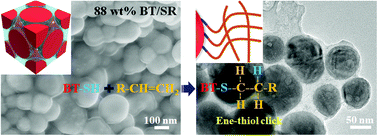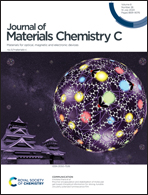Chemically bonding BaTiO3 nanoparticles in highly filled polymer nanocomposites for greatly enhanced dielectric properties†
Abstract
Dielectric nanomaterials offer great promise for diverse technological applications such as capacitors, actuators, and sensors. Unfortunately, the exploitation of desirable dielectric properties in polymer nanocomposites is a great challenge due to lack of efficient routes to achieve uniform dispersion of nanoparticles and good compatibility of interfaces at high nanoparticle loadings. A dilemma between the nanofiller loading and dispersion as well as interfacial compatibility makes it impossible to fully exploit the intrinsic polarization of the nanoparticles. Herein, we solve such a dilemma and fabricate highly filled barium titanate/silicone rubber (BT/SR) nanocomposites through chemically bonding BT nanoparticles with SR by “thiol–ene click” and isostatic pressing techniques. BT loading varies from 88 wt% to 97 wt% without compromising the uniform dispersion quality and good interfacial adhesion with the SR matrix. The 90 wt% BT nanocomposite shows an optimum dielectric constant as high as 55, while its loss tangent can be kept as low as 0.019 at 103 Hz. Meanwhile, it displays good stability of dielectric properties from room temperature up to 100 °C. In addition, the breakdown strength just decreases slightly compared to neat SR (97 MV m−1) but is still beyond 75 MV m−1. The present work provides a facile strategy towards superior dielectric polymer nanocomposites.



 Please wait while we load your content...
Please wait while we load your content...